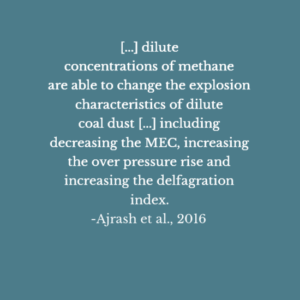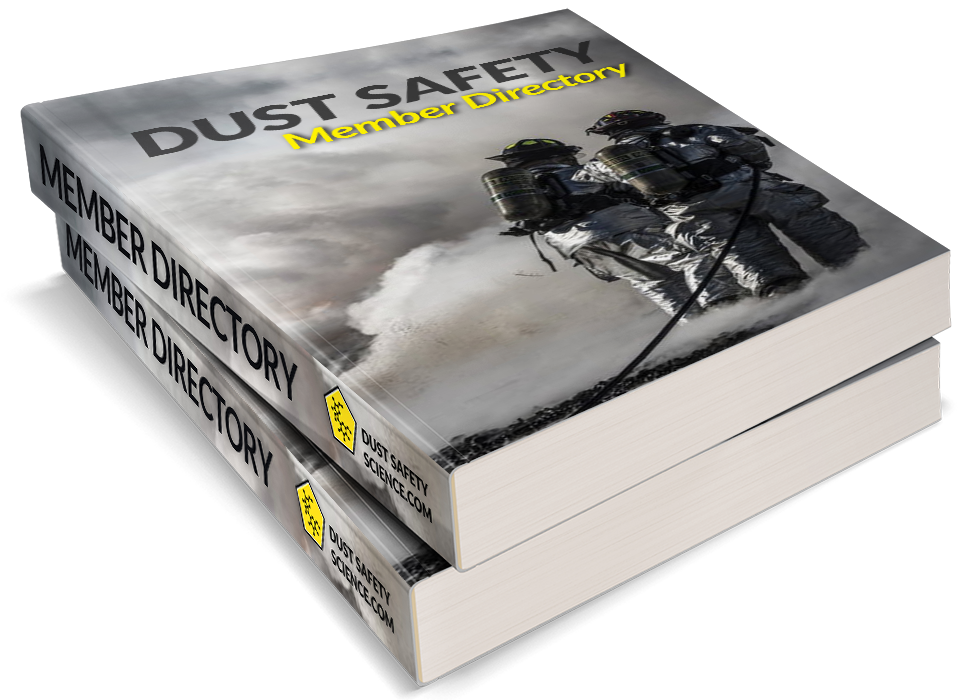1-Sentence-Summary: Explosion parameters and flammability limits of dilute coal dust and methane mixtures are shown to be very sensitive to ignition energy.
Authors: M. Ajrash, J. Zanganeh, and B. Moghtaderi
Read in: Three Minutes
Favourite quote from the paper:

These authors perform explosion testing of dilute mixtures of coal dust and methane gas as may be seen in mine ventilation systems. The dust concentrations range from 10-100 g/m3 and the gas concentrations from 0.75-1.25% by volume. The mean coal dust particle size is 30 µm.
The 20-L explosion chamber is used for the experimental tests and ignition energies of 1, 5, and 10 kJ are used. Other than the ignition energy ASTM E1226-12 is followed.
The authors present pressure-time traces, snapshots from slow-speed video of the explosion process, and summary plots for maximum pressure and maximum rate of pressure rise. They also review the explosability limits of the hybrid mixtures and compare to Le Chatelier’s Law and the relation proposed by Bartknecht. Lastly, a new flammability correlation is proposed and fitted to the experimental data with different ignition energies.
Three of the main findings from this paper are:
- Ignition energy has a larger effect on maximum pressure and rate of pressure rise at lower dust and gas concentrations than at higher concentrations.
- Dilute mixtures of methane gas and coal dust showed a two-stage explosion process.
- The explosion limits of coal dust and methane gas lie between Le Chatelier’s Law and the relation proposed by Bartknecht and Increased ignition energy tends to widen the limits.
The following sections outline the main findings in more detail. The interested reader is encouraged to view the complete article at the link provided below.
Finding #1: Ignition energy has a large effect on explosion severity for dilute hybrid concentrations
The experimental results demonstrate that hybrid explosion enhancement is strongly dependent on ignition energy as the fuel concentrations are reduced. For 50 and 100 g/m3 and less than 2.5% methane, the maximum overpresure increases from 0 bar to 3.5 bar with different ignition energies. However, above 2.5% methane the maximum pressure is insensitive to changes in ignition energy.
The maximum rate of pressure rise of dilute mixtures is also very sensitive to ignition energy. In all cases the pressure rise rate increases by a factor of 2-3 times as the ignition energy is increased from 1 to 10 kJ.
Finding #2: At dilute concentrations a two-stage explosion process occurred
Pressure time traces and high-speed images demonstrate a two-stage explosion process. The methane appears to react first followed by a secondary coal dust explosion. This multi-stage process has been seen before by Denkevits, 2007 and Denkevits and Hoess, 2015 for hydrogen/graphite and hydrogen/aluminum mixtures, respectively.
Finding #3: The explosion limits of coal/methane mixtures lie between Le Chatalier’s Law and Bartknecht’s relation
The current authors explore the flammability limits of coal/methane hybrid mixtures. The results demonstrate that in all cases the limits fell between Le Chatelier’s Law and the relation proposed in the text book of Bartknecht (Dust Explosions: Course, Prevention, and Protection). This shows that the hybrid explosion limits are wider than predicted by Le Chateliers Law, but more fuel is needed than predicted by Bartknecht’s relation.
A new equation is proposed based on Barthknecht’s relation but with two adjustable parameters. From the experimental data it is shown that different parameters are needed as the ignition energy changes. As the ignition energy is increased, the explosibility limits moved closer to the relation proposed by Bartknecht.
My Personal Take-Aways From
“Effects of Ignition Energy on Fire and Explosion Characteristics of Dilute Hybrid Fuel in Ventilation Air Methane”
This paper is useful for anyone in the mining industry or involved in ventilation of trace amounts of dust and gas. The experimental data is well characterized and the high-speed images and pressure-time traces demonstrate specific hybrid explosion phenomena. Other process safety papers focusing on coal dust and methane gas mixtures may also be valuable to these readers (e.g., see the keyword mining industry)
The finding that a two stage explosion occurs at such dilute methane concentrations is interesting and potentially unexpected. From the high-speed images combustion of the methane gas is clearly visible although its concentration is much to low to propagate a flame alone (1.25%). It seems probable in this case that the first stage of the two-stage explosion must have some hybrid phenomena occurring for the flame to propagate. This is followed by the secondary and slower explosion of the remaining dust. These results are useful as other studdies reviewing this phenomena (e.g., Denkevits, 2007 and Denkevits and Hoess, 2015) only test above the gas flammability limit.
The lower flammable testing for coal/methane mixtures is also useful to the research community. Other studies such as Jiang et al., 2014 and Jiang et al., 2015 are actively tackling the unsolved hybrid flammability limit problem. It would be interesting in the current study to see if the two tuning parameters are still variable if the lower flammability limit of the gas in the equation is taken as the value for the ignition energy being tested, instead of held fixed at the value determined from spark ignition.
Full Citation: [bibtex file=references.bib key=Ajrash2016]
[otw_shortcode_button href=”http://www.sciencedirect.com/science/article/pii/S0950423015300929″ size=”medium” icon_position=”left” shape=”square”]> > Get The Article[/otw_shortcode_button]
